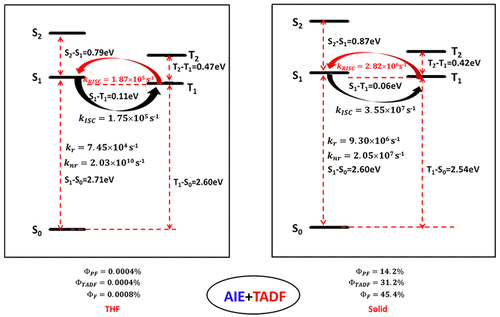当前位置:
X-MOL 学术
›
J. Phys. Chem. C
›
论文详情
Our official English website, www.x-mol.net, welcomes your
feedback! (Note: you will need to create a separate account there.)
Excited State Properties of a Thermally Activated Delayed Fluorescence Molecule in Solid Phase Studied by Quantum Mechanics/Molecular Mechanics Method
The Journal of Physical Chemistry C ( IF 3.3 ) Pub Date : 2018-01-19 00:00:00 , DOI: 10.1021/acs.jpcc.7b10238 Jianzhong Fan 1 , Yuchen Zhang 1 , Yong Zhou 1 , Lili Lin 1 , Chuan-Kui Wang 1
The Journal of Physical Chemistry C ( IF 3.3 ) Pub Date : 2018-01-19 00:00:00 , DOI: 10.1021/acs.jpcc.7b10238 Jianzhong Fan 1 , Yuchen Zhang 1 , Yong Zhou 1 , Lili Lin 1 , Chuan-Kui Wang 1
Affiliation

|
Excited state properties of a thermally activated delayed fluorescence molecule (4-(10H-phenoxazin-10-yl)phenyl)(dibenzo[b,d]thiophen-2-yl)methanone (DBT-BZ-PXZ) are theoretically studied in liquid (tetrahydrofuran (THF)) and solid phases, respectively. Solvent environment in THF is considered by polarizable continuum model (PCM) and the molecule in solid phase is investigated by a combined quantum mechanics and molecular mechanics (QM/MM) method. Results show that the geometrical changes between ground state (S0) and lowest singlet excited state (S1) are hindered in solid phase by the restricted intramolecular rotation (RIR) and restricted intramolecular vibration (RIV) effects, which brings smaller values of Huang–Rhys (HR) factors and reorganization energies compared to those in liquid phase. Thus, nonradiative energy consumptions are suppressed and enhanced fluorescent efficiency is found in solid phase. The calculated prompt fluorescence efficiency (ΦPrompt) and delayed fluorescence efficiency (ΦTADF) in solid phase are 14.2% and 31.2% respectively, which demonstrates the aggregation induced emission (AIE) mechanism for DBT-BZ-PXZ. Moreover, temperature dependence of the reverse intersystem crossing (RISC) rate is theoretically illustrated. Furthermore, a hybridized local and charge transfer (HLCT) property of the lowest triplet excited state (T1) is found. This transition feature brings a large spin–orbit coupling (SOC) constant and a small energy gap (ΔEst) between S1 and T1, which facilitates the RISC process. Our calculations give reasonable explanation for the previous experimental measurements and provide underlying perspectives for nonradiative assumptions of excited state energy.
中文翻译:

量子力学/分子力学方法研究固相热活化延迟荧光分子的激发态性质
理论上研究了热活化延迟荧光分子(4-(10 H-吩恶嗪-10-基)苯基)(二苯并[ b,d ]噻吩-2-基)甲酮(DBT-BZ-PXZ)的激发态性质。分别为液相(四氢呋喃(THF))和固相。通过极化连续体模型(PCM)考虑THF中的溶剂环境,并通过结合量子力学和分子力学(QM / MM)方法研究固相中的分子。结果表明,基态(S 0)和最低单重态激发态(S 1)之间的几何变化)受到分子内旋转(RIR)和分子内振动(RIV)的限制而在固相中受阻,与液相相比,它们的Huang-Rhys(HR)因子和重组能值更小。因此,抑制了非辐射能量的消耗,并且在固相中发现增强的荧光效率。所计算的提示荧光效率(Φ提示)和延迟荧光效率(Φ TADF固相的)分别为14.2%和31.2%,这证明了DBT-BZ-PXZ的聚集诱导发射(AIE)机理。此外,从理论上说明了反向系统间交叉(RISC)速率的温度依赖性。此外,发现了最低的三重态激发态(T 1)的混合的局部和电荷转移(HLCT)性质。这种过渡特征带来了大的自旋轨道耦合(SOC)常数和S 1与T 1之间的小能隙(ΔE st),这有助于RISC过程。我们的计算为先前的实验测量提供了合理的解释,并为激发态能量的非辐射假设提供了基础观点。
更新日期:2018-01-19
中文翻译:

量子力学/分子力学方法研究固相热活化延迟荧光分子的激发态性质
理论上研究了热活化延迟荧光分子(4-(10 H-吩恶嗪-10-基)苯基)(二苯并[ b,d ]噻吩-2-基)甲酮(DBT-BZ-PXZ)的激发态性质。分别为液相(四氢呋喃(THF))和固相。通过极化连续体模型(PCM)考虑THF中的溶剂环境,并通过结合量子力学和分子力学(QM / MM)方法研究固相中的分子。结果表明,基态(S 0)和最低单重态激发态(S 1)之间的几何变化)受到分子内旋转(RIR)和分子内振动(RIV)的限制而在固相中受阻,与液相相比,它们的Huang-Rhys(HR)因子和重组能值更小。因此,抑制了非辐射能量的消耗,并且在固相中发现增强的荧光效率。所计算的提示荧光效率(Φ提示)和延迟荧光效率(Φ TADF固相的)分别为14.2%和31.2%,这证明了DBT-BZ-PXZ的聚集诱导发射(AIE)机理。此外,从理论上说明了反向系统间交叉(RISC)速率的温度依赖性。此外,发现了最低的三重态激发态(T 1)的混合的局部和电荷转移(HLCT)性质。这种过渡特征带来了大的自旋轨道耦合(SOC)常数和S 1与T 1之间的小能隙(ΔE st),这有助于RISC过程。我们的计算为先前的实验测量提供了合理的解释,并为激发态能量的非辐射假设提供了基础观点。











































 京公网安备 11010802027423号
京公网安备 11010802027423号